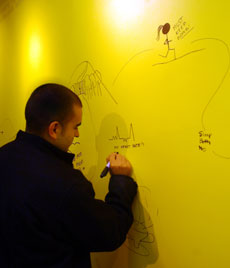Interactive art comes to C-U

Shira Weissman
October 13, 2004
Standing in front of a bright yellow wall, dozens of students strap on headphones and listen to an artist’s voice. Grabbing big permanent markers, they either draw pictures or write statements such as “I am who I am” on the piece of artwork.
Adam Pendleton, a conceptual artist from New York, originally created this piece 10 months ago as part of an exhibit called “Optimo: Optimism in Contemporary Art” in Marfa, Texas.
Pendleton’s exhibit is being displayed by The Illinois Program for Research in the Humanities in the open space at the front of its building, 805 W. Pennsylvania Ave., in Urbana. In the past, IPRH offered this space to artists from on and off campus. The director of the program, Matti Bunzl, first became interested in Pendleton’s art after seeing his works in a Chicago art gallery. Pendleton said Bunzl then asked him to bring his interactive exhibit to campus.
“We looked into Adam’s work and it seemed well-suited for us,” said Christine Catanzarite, associate director of IPRH.
Catanzarite said IPRH’s theme this year is “Difference,” which is clearly evident in Pendleton’s work.
Get The Daily Illini in your inbox!
IPRH used to have a coordinator in charge of creating artwork around their themes, but recently began asking artists to exhibit their own works. Catanzarite said this gives the artist a chance to interact with many people.
She said it has been interesting to see Pendleton’s yellow wall evolve. Pictures have been taken to document the additions to the wall, which will be turned into a slideshow of images.
Most of Pendleton’s work involves listening to audio recordings, but this is one of the only pieces that invites the public to interact with the artwork through writing.
Pendleton said he likes using headphones because they are personal and private – as opposed to playing the recording for everyone to hear at the same time.
Along the top of the wall, excerpts from Reinaldo Arenas’ novel Farewell to the Sea and Pendleton’s own writing are painted in silver. There is also a worksheet accompanying the artwork that allows viewers to follow along with the eight recorded tracks. For example, one audio track recorded Pendleton saying: “You are.” The track then instructs participants to finish that sentence on the worksheet or the wall. He also asks a number of questions – such as “Are you clarity or desire?” – that the listeners are supposed to answer.
Pendleton said he does not care what is written on the wall, but thinks it is important that people do write on it.
“The framework of the work is queer, black and conceptual art and how they are infused into art,” Pendleton said. “The structure of the work explores linguistics – the tone, rhythm and content.”
The exhibit is free and open to the public. Catanzarite said people can see and interact with the piece until today at 5 p.m.
Nick Brown, a graduate student, brought his art class to the IPRH building.
“I thought it would be a good opportunity to see and interact with the artist,” Brown said.
Pendleton’s artwork fit well with the structure of Brown’s class, he said.
“Being here in front of (the wall), I didn’t get as much as I did when I stepped away and listened to them talk about it,” said Alan Fleming, sophomore in FAA.
On Monday and Tuesday, Pendleton and scholars hosted panel discussions at 4 p.m. The panels discussed Pendleton’s work as “queer art” on Monday and focused on his work as “black art” on Tuesday.
Audrey Petty, English and creative writing professor, said she found several parallels between black art and Pendleton’s work.
“One (parallel) that struck me right away was the call and response … and the emphasis on communication,” Petty said, referring to the audio recordings.
Nichole Rustin, associate professor of African-American studies, said she felt overwhelmed at first because she tried to listen to the compact disc and read everything that was written on the wall.
“But then I took it step by step,” Rustin said.
When asked if his work was “black art,” Pendleton said, “Sure, it’s black art. Sure, it’s white art. Sure, it’s good. Sure, it’s bad. There are elements that are good and bad and quickly referenced as black and white.”
Today at 4 p.m., Pendleton will lecture and perform. Afterward, Lisa Dixon, theater professor; Kevin Hamilton, assistant professor in art and design; and Kathleen Harleman, director of Krannert Art Museum, will hold a panel discussion.






